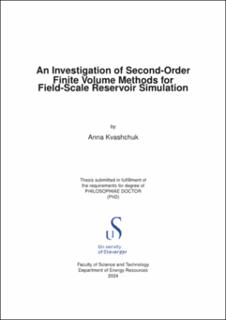| dc.contributor.advisor | Klöfkorn, Robert | |
| dc.contributor.advisor | Sandve, Tor Harald | |
| dc.contributor.advisor | Evje, Steinar | |
| dc.contributor.author | Kvashchuk, Anna | |
| dc.date.accessioned | 2024-04-12T06:27:03Z | |
| dc.date.available | 2024-04-12T06:27:03Z | |
| dc.date.issued | 2024 | |
| dc.identifier.citation | An Investigation of Second-Order Finite Volume Methods for Field-scale Reservoir Simulation by Anna Kvashchuk, Stavanger : University of Stavanger, 2024 (PhD thesis UiS, no. 752) | en_US |
| dc.identifier.isbn | 978-82-8439-229-5 | |
| dc.identifier.issn | 1890-1387 | |
| dc.identifier.uri | https://hdl.handle.net/11250/3126187 | |
| dc.description.abstract | This thesis focuses on improving the accuracy of numerical simulation of flow in subsurface reservoirs by using second-order finite volume methods. The first-order finite volume method, commonly used in reservoir simulation, is known to suffer from excessive numerical diffusion, leading to inaccuracies in the front position, breakthrough time, etc. Refining the computational grid is one way to increase accuracy; however, it significantly increases computational costs.
Higher-order numerical methods offer a more accurate representation of the solution without the need for grid refinement. This study compares three second-order finite volume methods with respect to their accuracy, convergence rate, and computational efficiency for modeling immiscible fluid displacement.
Two second-order finite volume methods were implemented in the open-source reservoir simulator OPM Flow. This allowed us, first, to perform a study in the realistic reservoir modeling setting and, second, to make it readily accessible to anyone interested in improving reservoir simulations’ accuracy.
The implemented methods were validated against synthetic benchmarks and realistic field model Norne to critically evaluate the methods’ applicability to complex reservoir flow modeling, with a focus on enhanced oil recovery application. The evaluation shows that our best method, the second-order method with linear programming reconstruction, outperformed other tested second-order methods and provided sharper fluid front resolution compared to the traditionally used first-order method. Moreover, our best method’s solution on a coarse grid was on par with the refined-grid solution from the first-order method across the benchmarks. | en_US |
| dc.language.iso | eng | en_US |
| dc.publisher | University of Stavanger, Norway | en_US |
| dc.relation.ispartofseries | PhD thesis UiS; | |
| dc.relation.ispartofseries | ;752 | |
| dc.relation.haspart | Paper 1: Klöfkorn, R., Kvashchuk, A. & Nolte, M. (2017) Comparison of linear reconstructions for second-order finite volume schemes on polyhedral grids. Computational Geosciences, 21, 909–919. DOI: 10.1007/s10596-017-9658-8. This paper is not included in the repository due to copyright restrictions. | en_US |
| dc.relation.haspart | Paper 2: Kvashchuk, A., Klöfkorn, R. & Sandve, T.H. (2019) Comparison of Higher Order Schemes on Complicated Meshes and Reservoirs. In SPE Reservoir Simulation Conference, Galveston, Texas, USA. DOI: 10.2118/193839-MS. This paper is not included in the repository due to copyright restrictions. | en_US |
| dc.relation.haspart | Paper 3: Kvashchuk, A., Klöfkorn, R. & Sandve, T.H. (2023) A Second-Order Finite Volume Method for Field-Scale Reservoir Simulation. Transport in Porous Media, 150, 109- 129. DOI: 10.1007/s11242-023-01999-1 | en_US |
| dc.rights | Navngivelse 4.0 Internasjonal | * |
| dc.rights.uri | http://creativecommons.org/licenses/by/4.0/deed.no | * |
| dc.subject | petroleumsteknologi | en_US |
| dc.title | An Investigation of Second-Order Finite Volume Methods for Field-scale Reservoir Simulation | en_US |
| dc.type | Doctoral thesis | en_US |
| dc.rights.holder | ©2024 Anna Kvashchuk | en_US |
| dc.subject.nsi | VDP::Teknologi: 500 | en_US |

